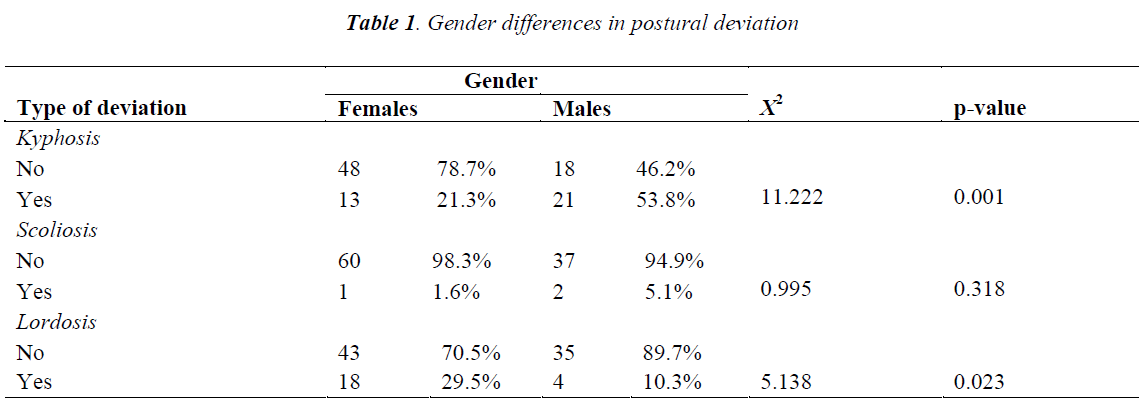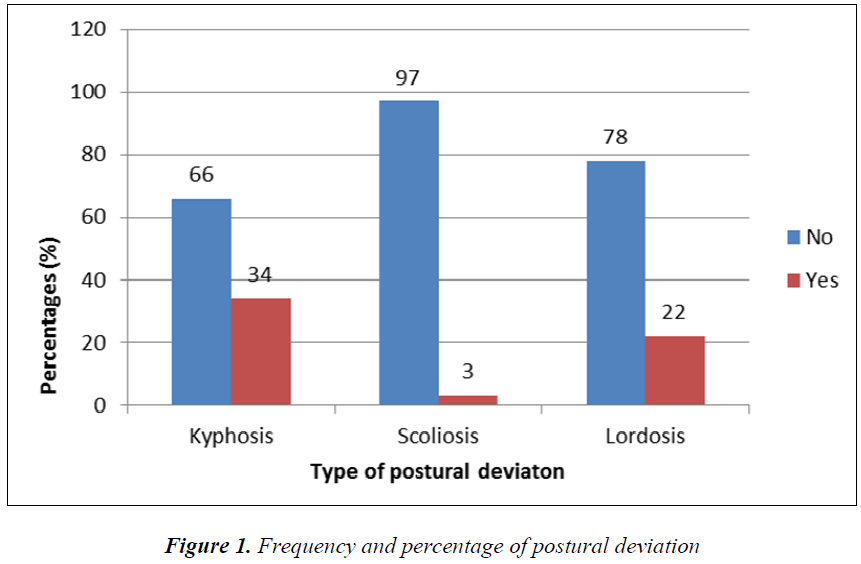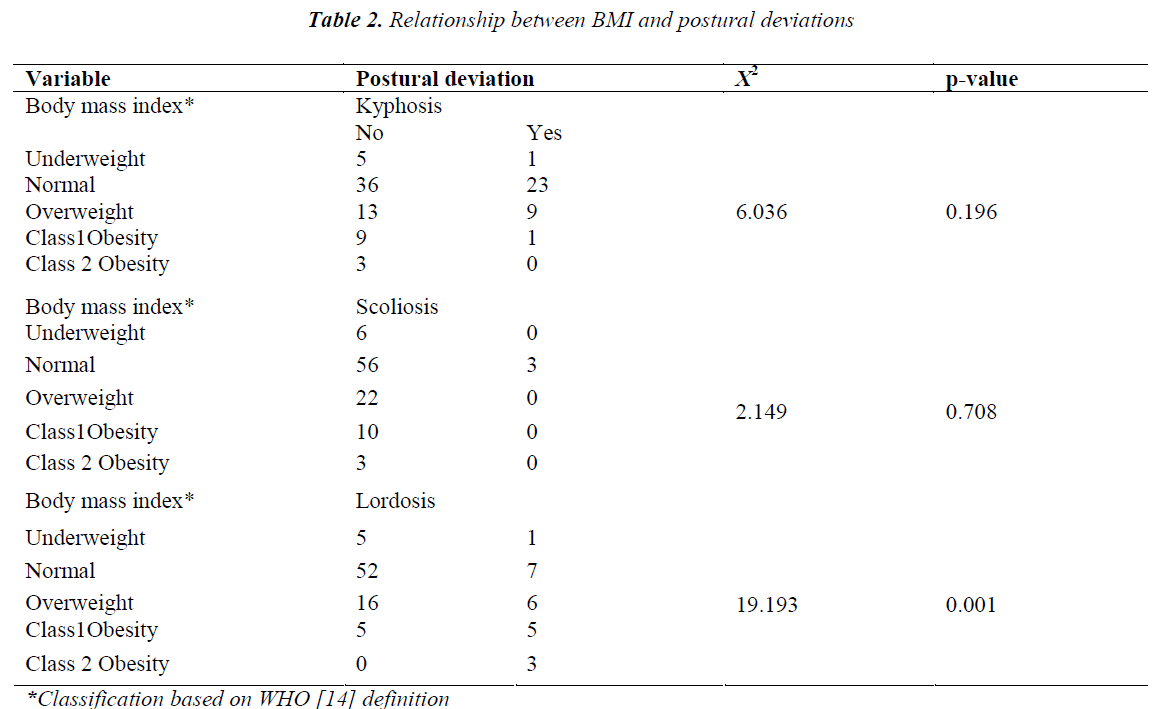ISSN: 0970-938X (Print) | 0976-1683 (Electronic)
Biomedical Research
An International Journal of Medical Sciences
- Biomedical Research (2015) Volume 26, Issue 3
The relationship between postural deviations and body mass index among university students.
Centre for Biokinetics, Recreation and Sports Science, University of Venda, Thohoyandou, South Africa
- Corresponding Author:
- Goon DT
Centre for Biokinetics, Recreation and Sports Science
University of Venda
Thohoyandou, South Africa
Accepted Date: April 04 2015
The purpose of this study was to determine the relationship between postural deviations and body mass index (BMI) among University of Venda students. This cross-sectional survey involved 100 purposively selected students in the Centre for Biokinetics, Recreation and Sports Science, University of Venda, South Africa. Height and weight were measured and BMI determined. The lateral, anterior and posterior views of postural deviations (kyphosis, scoliosis, and lordosis) were assessed. The mean age of the participants was 22±2.4 years. Majority (34%) of the participants had kyphosis, lordosis (22%) and scoliosis (3%). There was a significant difference between females and males with kyphosis and lordosis (X2= 11.222, p= 0.001) and (X2= 5.138, p= 0.023), respectively. There was no significant relationship between BMI and kyphosis and scoliosis (X2= 6.036, p=0.196) and (X2= 2.149, p= 0.708), respectively. However, there was significant difference between BMI and lordosis (X2=19.193, p=0.001). The prevalence of postural deviations was in the order of kyphosis>lordosis> scoliosis; with kyphosis being the most common type of postural deviation among the University of Venda students. There is no significant relationship between BMI and kyphosis as well as scoliosis. However, the inverse relationship between BMI and lordosis suggests increasing risk of developing lordosis as BMI increases. There is a significant gender difference in kyphosis and lordosis with the female students having higher prevalence of these postural deviations compared to the males. There is need to educate as well as design intervention measures to correct bad posture among the students as this could cause irreversible musculoskeletal, neurological and pathological damage in future.
Keywords
Postural deviations, kyphosis, scoliosis, lordosis, BMI, University students, South Africa
Introduction
Posture is the alignment and maintenance of body segments in certain positions such as standing, walking, lying or sitting [1,2]; and is the most important factors affecting physical and mental status of individuals through their lives [1,2]. The Posture Committee of American Academy of Orthopaedics in 1994 defines posture as the regular and balanced arrangement of skeletal components so as to preserve supportive structures of the body from injury and progressive deformation [3,4]. Several factors could affect posture in humans including familial, anatomical structure impairments, postural habits and occupation [2].
Bad posture may be attributed to muscle and emotional issues, which could generate positional or structural deviations if the individual remains in inappropriate positions for a long time [5]. Although postural deviation is commonly associated with the spine, other parts of the body have also been implicated in postural mal-alignment [6]. It has been shown that if body segments are held out of alignment for extended periods of time, muscles becomes shortened or lengthened in position [7] thus affecting muscle efficiency; and predisposing individuals to musculoskeletal, neurological and pathological conditions [7,8]. In this regard, a decrease or increase in the normal body curves might result to uneven pressure at the joints, ligaments, muscles and bones [6] and failure to institute timely corrective measures, degenerative changes will occur leading to postural deviation [9] This phenomenon has been widely studied in several fields such as anthropology, anatomy and orthopaedics because of its significance in the context of human movement and development [9,10]. Posture analysis is crucial for clinical assessments in physical medicine and rehabilitation [2]. Exploring the relation between postural balance and anthropometric measurements is important in order to determine the postural deviations in developing treatment programmes for postural scoliosis, increasing lumbar lor dosis, straight back posture; and assessing the different deformities that may have occurred [11].
The best body posture can be observed in children; however, as individuals grow older, they develop habits (change in gait, adopting abnormal sitting and standing positions) that predispose them to poor posture [8]. Poor posture occurs in all works of life and its prevalence is increasingly on the rise [10] despite efforts to educate people on the effects of poor posture, the condition remains a daunting problem [9] particularly in the adult population.
Through observation, there seems to be an increase in postural deviation among students at the University of Venda; the reason for this is not known and the students are not aware of the developing trend. It becomes imperative that this phenomenon is studied. It is envisaged that findings of the study will provide knowledge on the prevalence of postural deviation and this will help to educate the students on prevention and management of postural deviations. Therefore, the study was designed to assess postural deviations (kyphosis, scoliosis and lordosis) in relation to body mass index (BMI) among university students at the Centre for Biokinetics, Recreation and Sports Science, University of Venda, Thohoyandou, South Africa.
Methods
Research setting
This study was conducted at the Centre for Biokinetics, Recreation and Sport Science in University of Venda, a rural-based university in South Africa; located in Thohoyandou town in Vhembe district Limpopo province, about 70 km from Makhado Town.
Research design
This was a cross-sectional study involving 100 students (males and females) in the Centre for Biokinetics, Recreation and Sport Science, University of Venda, Thohoyandou, South Africa. The number of registered students for the 2013 academic year in the Centre for Biokinetics, Recreation and Sport Science was 287 [12]. Purposive sampling was used to select 100 participants (25 students in each level) covering levels 1-4.
Ethical considerations
Centre for Biokinetics, Recreation and Sport Science grant approval for the study. Permission to conduct the study at University of Venda was obtained from the University of Venda; Registrar’s Office through the Head of Department and the Dean of School of Health Sciences. Participants were briefed on the aim and nature of the study and the procedures involved. They were told that their participation in the study is voluntary and that they are free to withdraw from the study should they feel unsatisfied with the way the study is being conducted. The anonymity and confidentiality of the participants were assured. Participants who agreed to participate signed the consent form.
Anthropometric measurements
Weight and height were determined according to the standard anthropometric methods of the International Society for the Advancement of Kinanthropometry (ISAK) [13]. Weight was measured in kilogrammes (kg) using a bathroom digital scale. Height was measured to the nearest of 0.1 cm, using a mounted stadiometer. Body mass index (BMI) was determined according to WHO [14] classification.
Postural assessment
Postural assessment criterion as outlined by [15] was adopted. The procedure involves drawing a plumb line vertically and asking the participants to stand erect on a bench; marking the five anatomical points which include the ear, acromion, greater trochanter, patella and malleolus. Participants were assessed from the lateral, posterior and anterior views.
Participants were observed without shirt in lateral view. The ear lobe was in line with the tip of the shoulder (acromion process) and the high point of the iliac crest. The lateral line, dividing the body into front and back (coronal plane) indicated normal posture. If the chin pokes forward, it indicates lumbar lordosis. Each spinal segment has normal curves and the shoulders in proper alignment; if the shoulders drops forward it indicate scapula protraction and rounded shoulders. The pelvic angle is normal at 30 degrees but the posterior superior iliac spine should be slightly high than the anterior superior iliac spine. The knees are straight, flexed in recurvatum (hyperextended), usually the normal standing position of the knees are slightly flexed at 0 to 5 degrees and hyperextension of the knees may cause an increase in lordosis in the lumbar spine [15].
Anteriorly, the head was straight on the shoulders (midline) the tip of the nose and in line with the manubrium, sternum, xiphisternum and the umbilicus; this line divides the body into right and left (sagittal plane) and the upper trapezius neck line was equal on both sides. The levelling of the shoulders indicated normal posture. However, where the dominant side is slightly lower, the clavicle and acromioclavicular joint are level and equal and there is no protrusion, depression or lateralization of the sternum, ribs or costal cartilage. The waist angles were equal and arms were equidistance from the waist. However, individuals with scoliosis, one arm will hang closer to the body than the other arm. The carrying angles at each elbow are equal, and the normal angles vary from 5 to 15 degrees [15].
Participants were observed in posterior view. The shoulders were level and the head was in midline, the spines and the inferior angles of the scapulae were level. If the medial borders of the scapulae are equidistance from the spine, it indicates normal posture. Straight curved lateral spine indicates scoliosis; the ribs protrude or symmetrical on both sides with the waist angles equal. Arms were equidistant from the body and equally rotated; posterior superior iliac spines were at the same level, the higher one, suggests one leg was shorter or rotation of the pelvis may be present [15].
Deviations of the spine include: Lordosis (extension of the lumbar spine), Kyphosis (flexion of the thoracic region) and Scoliosis (lateral curvature of the spine) [10].
There was a significant difference between females and males with kyphosis and lordosis (X2= 11.222, p= 0.001) and (X2= 5.138, p= 0.023), respectively. However there was no significant difference between females and males in scoliosis (X2= 0.995, p= 0.318) (Table 1).
Statistical analysis
Descriptive statistics was presented in percentages. Chisquare was applied to test the significant relationship between variables. The statistical significance was set at p < 0.05. All statistical analyses were conducted using the Statistical Package for the Social Sciences (SPSS) version 21.0.
Results
The mean age of the participants was 22±2.4 years. Figure 1 indicates the type and percentage of postural deviation among the participants. Majority (34%) of the participants had kyphosis, 3% had scoliosis and 22% lordosis.
Table 2 indicates the relationship between body mass index (BMI) and postural deviation. There was no significant relationship between BMI and kyphosis and scoliosis (X2= 6.036, p=0.196) and (X2= 2.149, p= 0.708), respectively. However, there was a significant relationship between BMI and lordosis (X2=19.193, p=0.001).
Discussion
The present study was designed to assess the prevalence of postural deviation among University of Venda students which information is lacking. Such information might help to educate the students on prevention and management of postural deviations. The findings of this current study indicates that majority (34%) of the participants had kyphosis; lordosis (22%) while 3% had scoliosis. The finding also demonstrates significant gender difference in postural deviation with majority of the males and females having kyphosis and lordosis, respectively. In contrast, no significant gender difference was found for scoliosis. This finding corroborates a study in Southern Brazil [16] among students, which reported kyphosis in 16.6% of students, 33.2% and 27.9% had scoliosis and lordosis, respectively. Like the present study, females were less likely to have kyphosis than males but more likely to have lordosis (p=0.01) while scoliosis did not show significant difference (p=0.53). Similar results has been reported by other researchers [17,18] but the reason for this is poorly understood. However, some studies have suggested that females have increased lordosis angle [19,20] and greater buttock size [21], which may contribute to the higher rate of lordosis seen in female participants but this is not absolute as other studies observed no significant gender difference in lordosis [22] and kyphosis being more prevalent in females [23]. The gender difference observed in the present study may be due to the anatomical makeup of the student population where females have greater gluteal mass and the males are often slender and taller.
The finding of the present study demonstrates no significant relationship between BMI and kyphosis as well as scoliosis. However, there was an inverse relationship between BMI and lordosis suggesting an increasing risk of developing lordosis as the BMI increases. This is comparable to Abdullah et al. [24] study which found no relationship between BMI and kyphosis (p=0.198) and scoliosis (p=0.003); but observed a significant relationship between BMI and lordosis (p=0.000) [24]. Most overweight and obese individuals are likely to have lordosis because some have protruding stomach and big buttocks where the spine tries to hold the body upward, and in that process, develops arch at the lower back to hold the body upright [25]. A study conducted in Japan and Brazil [26] observed that among 32 morbid obese persons, obesity negatively affected anterior, posterior and lateral balance and led to genu valgum deformity in 84.4% of the patients.
Limitations of the study
The results of the present study should be interpreted with caution bearing in mind that other postural deviations were not assessed and indirect assessment of postural deviations was used. Also, this was a crosssectional study and, as such, a causal relationship between variables could not be established. Besides, the small sample of the participants limited the generalizability of the results to neither the entire University of Venda students nor the entire South African University students. As such, future studies should endeavour to utilise objective measures to assess postural deviations and include other forms of postural deviations as well as recruit larger samples in to generalise the findings.
Conclusion
The study demonstrated that there were students with postural deviations with prevalence in the order of: kyphosis>lordosis>scoliosis. Kyphosis was the most common type of postural deviation found among the University of Venda students. Gender and BMI were associated with postural deviation among the students. Apart from scoliosis, there was a significant gender difference in kyphosis and lordosis with the female students having higher prevalence of these postural deviations compared to the males. There is need to institute intervention measures to correct bad posture among the students which presents irreversible musculoskeletal, neurological and pathological damage in future.
References
- Young M. Review on postural realignment and muscularand neural component. J PhysEdu Sport 2011; 5: 170-173.
- Zagyapan R, Iyem C, Kurkcuoglu A, Pelin C, TekindalMA. The relationship between balance, muscles, and anthropomorphic features in young adults. Ant Res Int 2012; 146063: 1-6.
- Fabris De Souza SA, Faintuch J, Anna AF, Gama- Rodrigues JJ, deBalisa Fonseca IC, de Melo RD. Postural changes in morbidly obese patients. ObesSurg 2005; 15: 1013-1016.
- Calliet R. Low back pain syndrome. In Davies FA (4th ed.) Philadelphia, USA.
- Knoplich J. Enfermidades da coluna vertebral: umavisãoclínica e fisioterapêutica. 3rd ed. São Paulo: Robe; 2003.
- Trew M, Everett T (2001). Human Movement. 4th ed. USA: Harcourt Ltd.
- Purenovic T (2007). Review of national and international research studies in postural deformities. J PhysEdu Sports, 5: 139-152.
- Brianezi L, Cajazeiro DC, Maifrino LBN (2011). Prevalence of postural deviation in school education and professional practice of physical education. J MorpholSci, 28: 35-36.
- Hrysomallis C, Goodman C (2001). A review of resistance exercise and posture realignment. J StrengCond Res, 15: 385-390.
- Shultz SJ, Houghlum PA, Perrin DH (2010).Therapeutic Exercise for Musculoskeletal Injuries. 3rd ed. United States: Human Kinetics.
- Griegel-Morris P, Larson K, Mueller-Klaus K, Otis CA (1992). Incidence of common postural abnormalities in the cervical, shoulder and thoracic regions and their association with pain in two age groups of healthy subjects.PhysTher, 72: 425-431.
- Centre for Biokinetics, Recreation and Sport Science (2013). Student’s registration sheet.University of Venda, Thohoyandou.
- Marfell-Jones M, Olds T, Stew A, Carter L (2006). International standards for anthropometric assessment.Australia: The International Society for the Advancement of Kinanthropometry.
- World Health Organisation (1995). Physical status: The use and interpretation of anthropometry. Geneva: WHO.
- Wilders CJ, Moss SJ, Leijenaar CJ (2005). Orthopaedicstudy guide. North West University: South Africa.
- Paulista R (2012). Postural deviations of students inSouthern Brazil-Scielo. J Clin, 64: 223-245.
- Straker LM, O’Sullivan PB, Smith A, Penny M (2009). Relationship between spinal posture in males and females. J Man Ther, 14: 321-329.
- Nazarian AB, Daneshioo A, Ghorbani L, Ghaedi H (2006). The prevalence of lordotic and kyphotic deformities among age groups. J Res Rehab Sci, 5: 1388.
- Youdas JW, Garrett TR, Egan KS, Therneau TM (2000).Lumbar lordosis and pelvic inclination in adults with chronic low back pain.PhysTher, 80: 261–75.
- Murrie VL, Dixon AK, Hollingworth W, Wilso H, Doyle, TA (2003). Lumbar lordosis: study of patients with and without low back pain. ClinAnat, 16: 144-147.
- Mosner EA, Bryan JM, Stull MA, Shippee R (1989). A comparison of actual and apparent lumbar lordosisin black and white adult females.Spine, 14: 310- 314.
- Been E, Pessah H, Been L, Tawil A, Peleg S (2007). New method for predicting the lumbar lordosis angle in skeletal material. The Anat Rec, 290: 1568-1573.
- Fon GT, Pitt MJ, ThiesAC Jr (1980).Thoracic kyphosis: range in normal subjects. Am J Roentqenol, 134: 979-983.
- Abdullah AM, McDonald R, Jaberzadeh M (2012). Effects of load and placements on postural deviations in healthy students. J Man Sci, 2: 313-315.
- Shumway-Cook A,Woollucott M (2002). Attention and the control of posture and gait. J Gait Posture, 16: 1-14.
- De Souz TO, GilCoury HJC (2005). Are postures adopted according to requested linguistic categories similar to those classified by the recording protocols? Appl Ergo, 36: 207-212.


